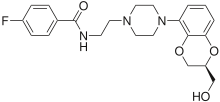Flesinoxan
 | |
| Clinical data | |
|---|---|
| Routes of administration | Oral |
| ATC code |
|
| Legal status | |
| Legal status |
|
| Identifiers | |
| |
JSmol) | |
| |
| |
Flesinoxan (DU-29,373) is a
antihypertensive drug,[1][2][4] flesinoxan was later found to possess antidepressant and anxiolytic effects in animal tests.[5][6] As a result, it was investigated in several small human pilot studies for the treatment of major depressive disorder, and was found to have robust effectiveness and very good tolerability.[7][8] However, due to "management decisions", the development of flesinoxan was stopped and it was not pursued any further.[9]
In patients, flesinoxan enhances
See also
References
External links
 Media related to Flesinoxan at Wikimedia Commons
Media related to Flesinoxan at Wikimedia Commons
